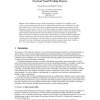Free Online Productivity Tools
i2Speak
i2Symbol
i2OCR
iTex2Img
iWeb2Print
iWeb2Shot
i2Type
iPdf2Split
iPdf2Merge
i2Bopomofo
i2Arabic
i2Style
i2Image
i2PDF
iLatex2Rtf
Sci2ools
VISUAL
1999
Springer
1999
Springer
Visual Presentations in Multimedia Learning: Conditions that Overload Visual Working Memory
How should we design visual presentations to explain how a complex system works? One promising approach involves multimedia presentation of explanations in visual and verbal formats, such as presenting a computer-generated animation synchronized with narration or on-screen text. In a review of three studies, we found evidence that presenting a verbal explanation of how a system works with an animation does not insure that students will understand the explanation unless research-based cognitive principles are applied to the design. The first two studies revealed a split-attention effect, in which students learned better when the instructional material did not require them to split their attention between multiple visual sources of information. The third study, revealed a modality effect, in which students learned better when verbal input was presented auditorily as speech rather than visually as text. The results support two cognitive principles of multimedia learning.
Approach Involves Multimedia | Cognitive Principles | Information Management | Research-based Cognitive Principles | VISUAL 1999 |
| Added | 05 Aug 2010 |
| Updated | 05 Aug 2010 |
| Type | Conference |
| Year | 1999 |
| Where | VISUAL |
| Authors | Roxana Moreno, Richard E. Mayer |
Comments (0)

